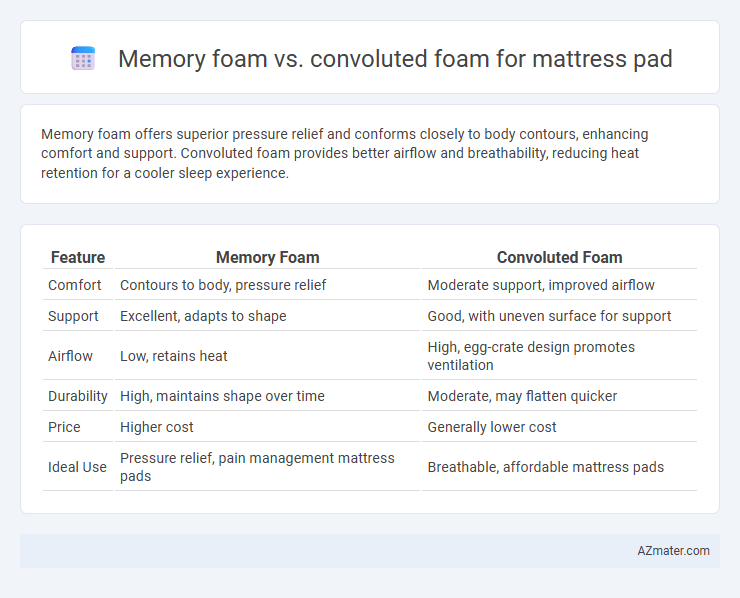Memory foam offers superior pressure relief and conforms closely to body contours, enhancing comfort and support. Convoluted foam provides better airflow and breathability, reducing heat retention for a cooler sleep experience.
Table of Comparison
| Feature | Memory Foam | Convoluted Foam |
|---|---|---|
| Comfort | Contours to body, pressure relief | Moderate support, improved airflow |
| Support | Excellent, adapts to shape | Good, with uneven surface for support |
| Airflow | Low, retains heat | High, egg-crate design promotes ventilation |
| Durability | High, maintains shape over time | Moderate, may flatten quicker |
| Price | Higher cost | Generally lower cost |
| Ideal Use | Pressure relief, pain management mattress pads | Breathable, affordable mattress pads |
Introduction to Mattress Pad Materials
Memory foam mattress pads conform to the body by responding to heat and pressure, offering targeted support and pressure relief. Convoluted foam, characterized by its egg-crate or egg-carton texture, enhances airflow and provides moderate cushioning with a focus on breathability. These materials differ in density and structure, influencing comfort, durability, and temperature regulation for personalized sleep experiences.
What is Memory Foam?
Memory foam is a high-density polyurethane foam infused with viscoelastic chemicals, designed to respond to body heat and pressure by conforming closely to the sleeper's shape. It provides superior support and pressure relief by evenly distributing body weight, which helps reduce pain and improve sleep quality. Memory foam mattresses pads offer enhanced comfort and motion isolation compared to convoluted foam, making them a popular choice for people seeking personalized cushioning and durability.
What is Convoluted Foam?
Convoluted foam, also known as egg crate foam, features an uneven surface designed to improve airflow and provide targeted pressure relief by conforming to the body's contours. Memory foam offers slow-response cushioning with heat sensitivity, while convoluted foam enhances breathability and reduces heat buildup, making it ideal for mattress pads in warmer climates. Choosing between memory foam and convoluted foam depends on preferences for temperature regulation and firmness in mattress pad support.
Comfort and Support: Memory vs Convoluted Foam
Memory foam offers superior body contouring and pressure relief by conforming closely to body curves, providing targeted support and reducing pressure points. Convoluted foam, with its egg-crate design, enhances breathability and promotes better air circulation, delivering moderate support with a cushioned, flexible surface. Both foams improve mattress comfort, but memory foam excels in plush support while convoluted foam is preferred for ventilation and balanced firmness.
Pressure Relief Capabilities
Memory foam mattress pads provide superior pressure relief by conforming closely to body contours, evenly distributing weight, and reducing pressure points that cause discomfort. Convoluted foam offers targeted cushioning through its egg-crate design, enhancing airflow and providing moderate pressure relief but less contouring compared to memory foam. Studies show memory foam reduces peak pressure more effectively, making it ideal for individuals with joint pain or pressure sensitivity.
Temperature Regulation and Breathability
Memory foam mattress pads excel in pressure relief but often retain heat due to their dense structure, potentially causing discomfort during hot nights. Convoluted foam features an egg-crate design with increased airflow channels, significantly enhancing breathability and temperature regulation by dissipating body heat more effectively. Consumers seeking cooler sleep environments benefit from convoluted foam's superior ventilation compared to traditional memory foam.
Durability and Longevity
Memory foam mattress pads typically offer superior durability due to their high-density construction, which retains shape and support over time, often lasting 7-10 years with proper care. Convoluted foam mattress pads, characterized by their egg-crate design, may provide enhanced airflow but generally have lower density, leading to faster wear and a shorter lifespan, usually around 3-5 years. The choice between memory foam and convoluted foam significantly impacts the mattress pad's longevity, with memory foam being the more resilient option for long-term use.
Cost Comparison
Memory foam mattress pads typically cost more due to their high-density viscoelastic material that offers superior pressure relief and contouring properties. Convoluted foam mattress pads are generally more affordable, providing decent comfort with a distinctive egg-crate design that enhances airflow but uses less expensive foam types. Price differences can range from 20% to 50%, making convoluted foam a budget-friendly option without sacrificing basic cushioning benefits.
Best Uses and Ideal Sleepers
Memory foam mattress pads offer superior pressure relief and contouring, making them ideal for side sleepers and individuals with joint pain or arthritis. Convoluted foam pads provide enhanced airflow and a firmer support, suited for hot sleepers and those who prefer a more buoyant feel. Both options improve mattress comfort, but memory foam excels in body molding while convoluted foam enhances breathability and cooling.
Choosing the Right Foam for Your Mattress Pad
When choosing the right foam for your mattress pad, memory foam offers superior pressure relief and contouring by responding to body heat and shape, ideal for alleviating joint pain and improving sleep comfort. Convoluted foam, characterized by its egg-crate design, enhances airflow and breathability, reducing heat retention and promoting a cooler sleep environment. Select memory foam for personalized support or convoluted foam for increased ventilation, based on your specific comfort and temperature regulation needs.

Infographic: Memory foam vs Convoluted foam for Mattress pad
 azmater.com
azmater.com